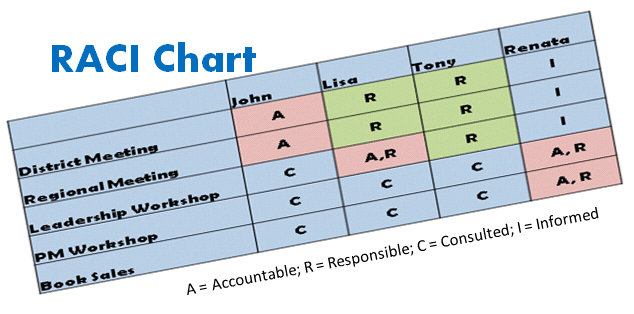Rarely does everyone on a team have the same understanding of who is engaged and involved in work activities. A RACI chart clarifies roles and responsibilities while attempting to prevent tasks and activities from falling through the cracks or being performed redundantly.
A RACI chart is used to avoid confusion, determine which team members are responsible for which pieces of work, and enforce accountability. It’s important that each member of your team understands what is expected from them, and this expectation includes understanding the interrelationship of the project tasks and who to work with when managing handoffs and sharing pertinent information.
Why is a RACI Chart useful?
- It clearly identifies the individual accountable for tasks and activities.
- It lets the stakeholders and team members know if some people are assigned too many or too few responsibilities on this project.
- It reduces miscommunications and attempts to assure that all the correct people are given the appropriate amount of information and engaged at the right time.
The role types – (R) Responsible, (A) Accountable, (C) Consulted, and (I) Informed are described below:
Responsible
The person that is assigned the role type “Responsible” is the one who performs the work. The person who is “Responsible” need not be “Accountable” {defined in the next section} for that task, even though in some cases the same person can be “Responsible” and “Accountable”. The degree of “Responsibility” can vary and multiple individuals can share the work of a single task. Also, work can be delegated. Using the RACI Chart we can see if a person has too many or too few deliverables and try to balance the workload. Some organizations will assign team roles rather than people’s names to enable flexibility in actually assigning and managing workload.
Accountable
“Accountable” is assigned to the person who has the final authority and has culpability for a given task. For any given task, there is only one person “Accountable”. This accountability cannot generally be delegated to another individual. At the extreme the “Accountable” person is the person who gets fired if things go tragically wrong, therefore being accountable requires an active understanding and management of the deliverables being executed by the “Responsible” team members. A regular function of the “Accountable” person is to justify the actions taken in support of completing a task.
Consulted
“Consulted” individuals are the people that are asked for advice usually before and during the performance of a task. When there are a large number of people who are assigned to the “Consulted” role and actively participate in their role, the time taken to accomplish a task can increase significantly. On the other hand too few or no “Consulted” roles assigned to a task could mean that the task has the risk of underperforming based on a lack of information or connection to its predecessor or successor tasks.
Informed
“Informed” individuals are the people who are updated after a task is completed. You need to assign the ‘Informed’ roles properly as otherwise, it may lead to miscommunication and delays in related activities. You need to make sure the right people are informed after a task is performed successfully. A good test for a project manager is to review if too many people are informed after a task, is everyone really necessary for inclusion. Adding people to the information email list is easy, but it’s inefficient for the organization if the information shared is not useful to the people receiving the message.
Here are a few team assignment rules of thumb. For every task, there should be one and only one person who is accountable. The accountable person is to be held culpable for delivery failure and praised for delivery success. The responsible team should have as many members as are necessary to get the work done in a timely and efficient manner. The consulted team members should have the experience and background to provide useful information and support to the people doing the work. The participants in the project that are interested in the results of a task to support their efforts are to be informed at the appropriate time.
In summary, RACI Charts can be a positive project management tool that greatly improves communication within a team and helps a team to communicate in a way that gets tasks done faster. If used correctly RACI Charts can reduce email clutter and can help the entire project team to stay productive. In the fast-paced business world, we can sometimes assume the blocking and tackling activities like communications will just happen, but as project managers, your role is to provide a framework and discipline so that things like efficient communications are not taken for granted and the RACI chart is a simple yet effective tool for assigning clear ownership, expected work effort, and communication paths. Use RACI Charts and notice the benefit!
About the author
John R. Hill, Jr. is a Computer Engineer, IT/PM Consultant and author, with over 30 years of software development, management, and project management experience.



